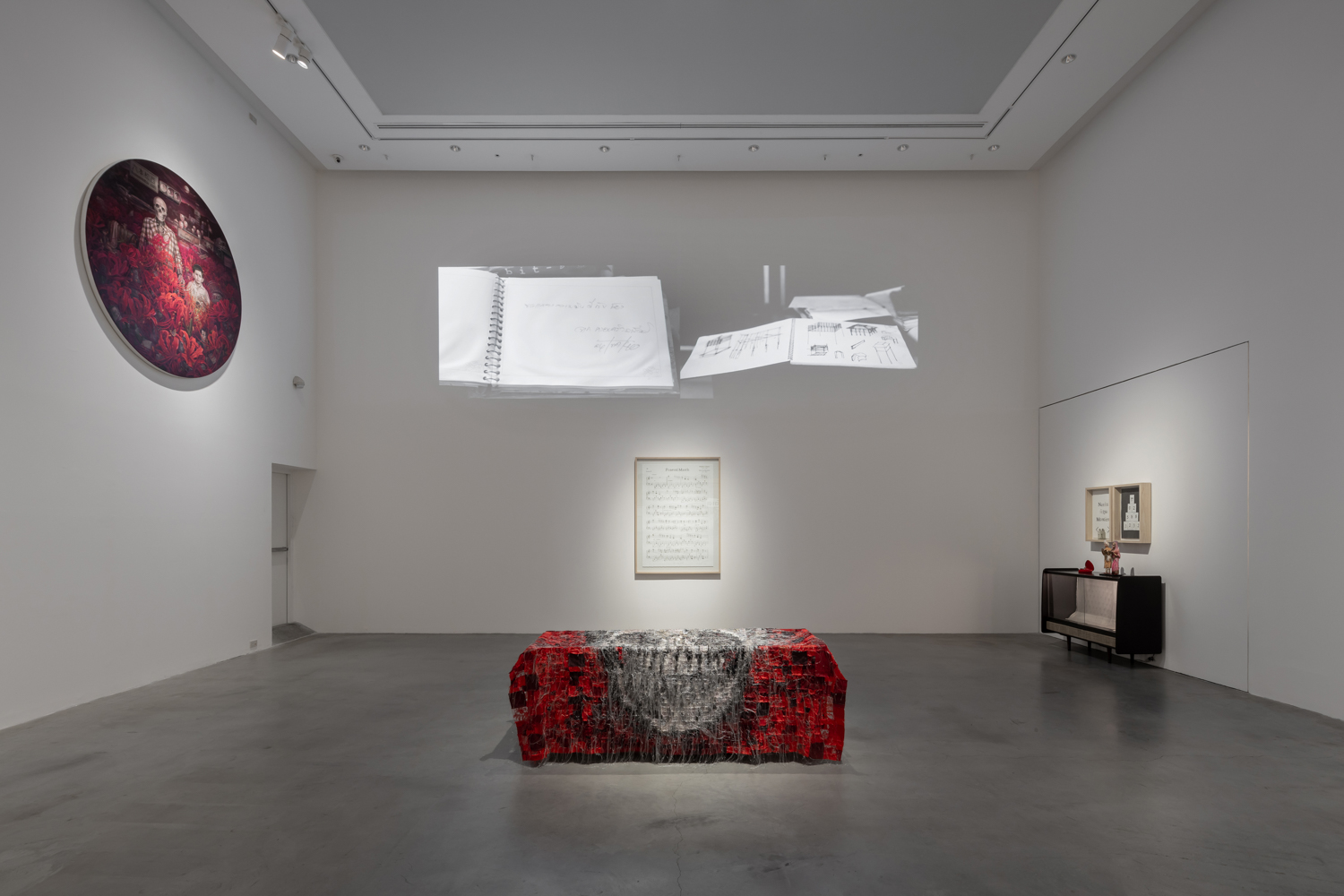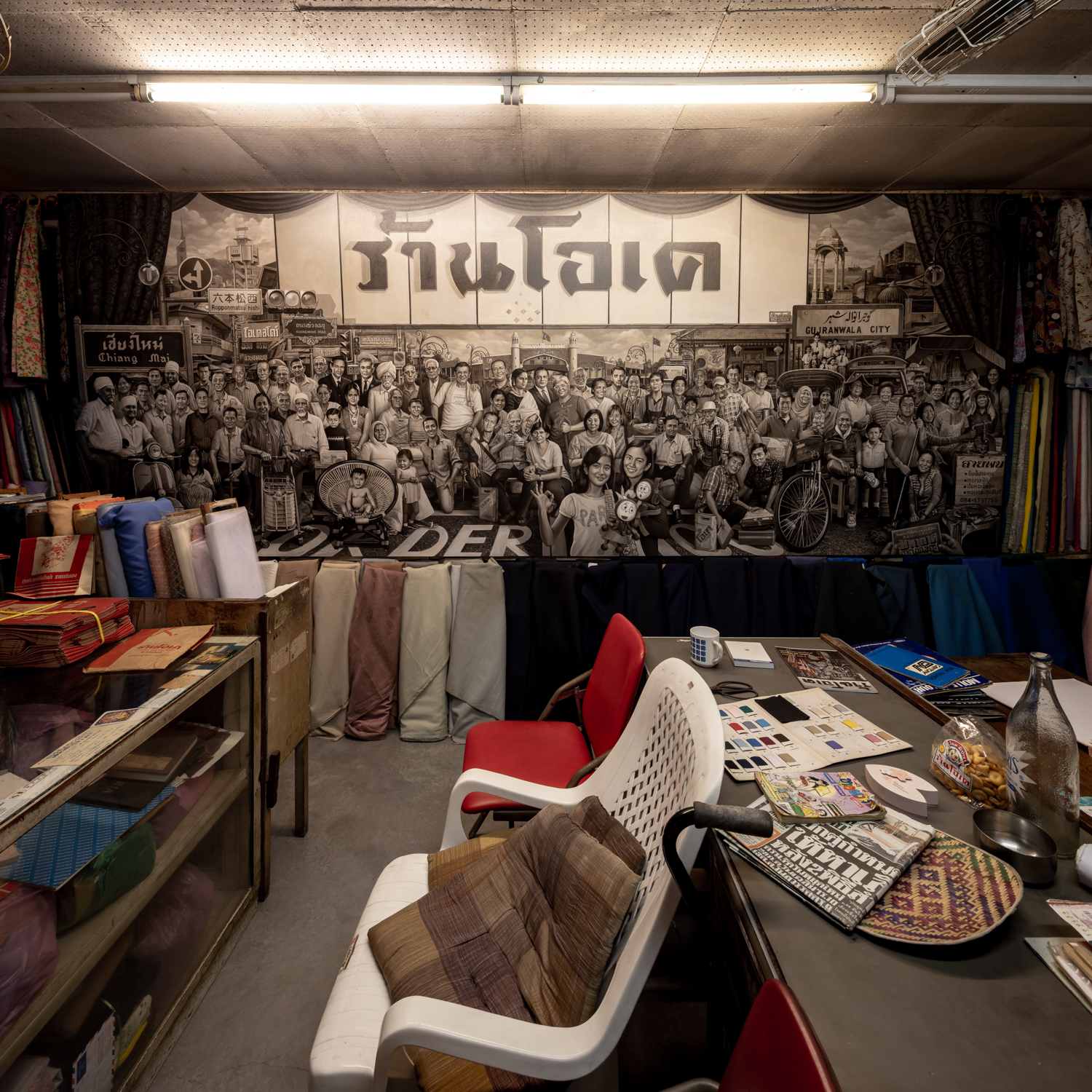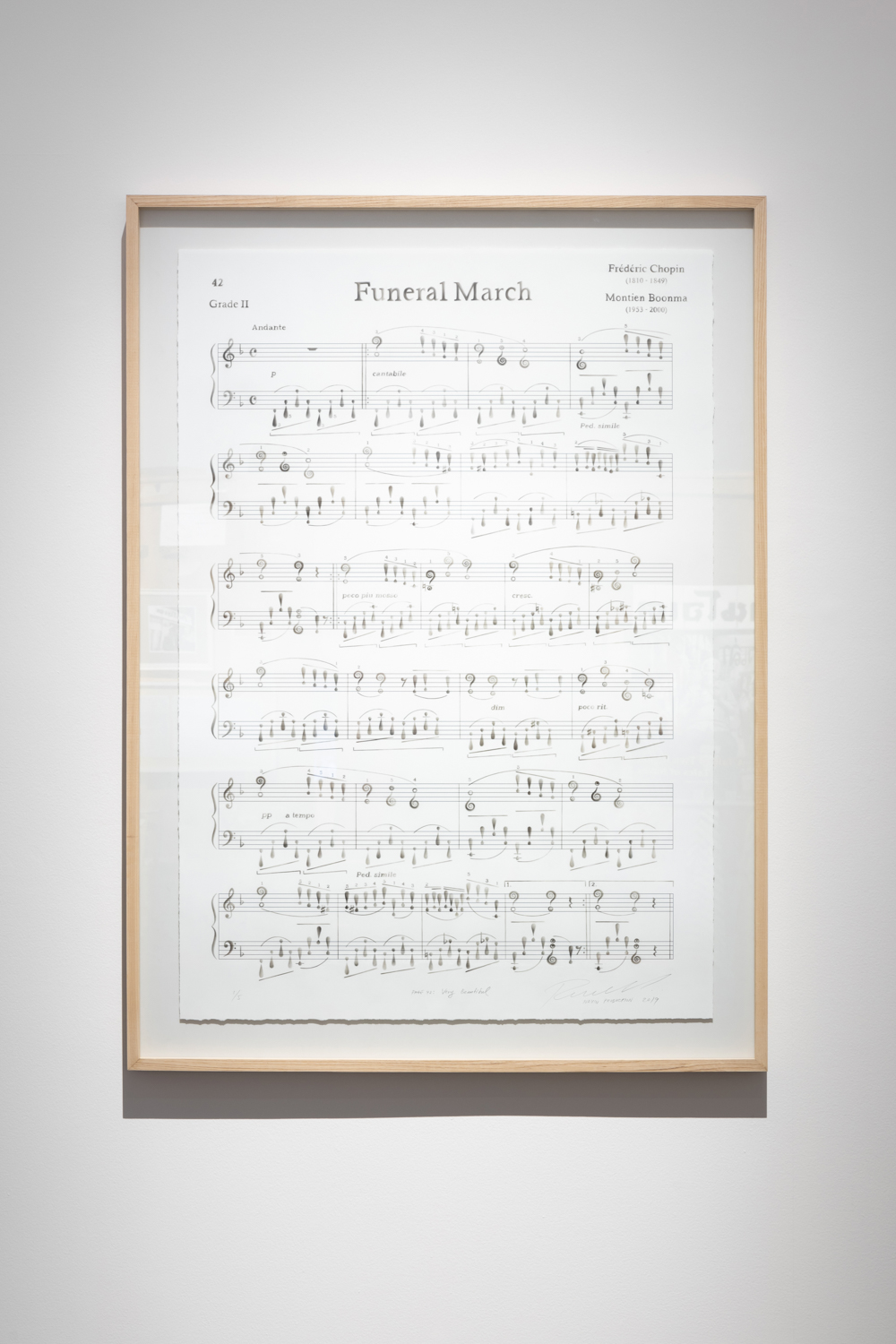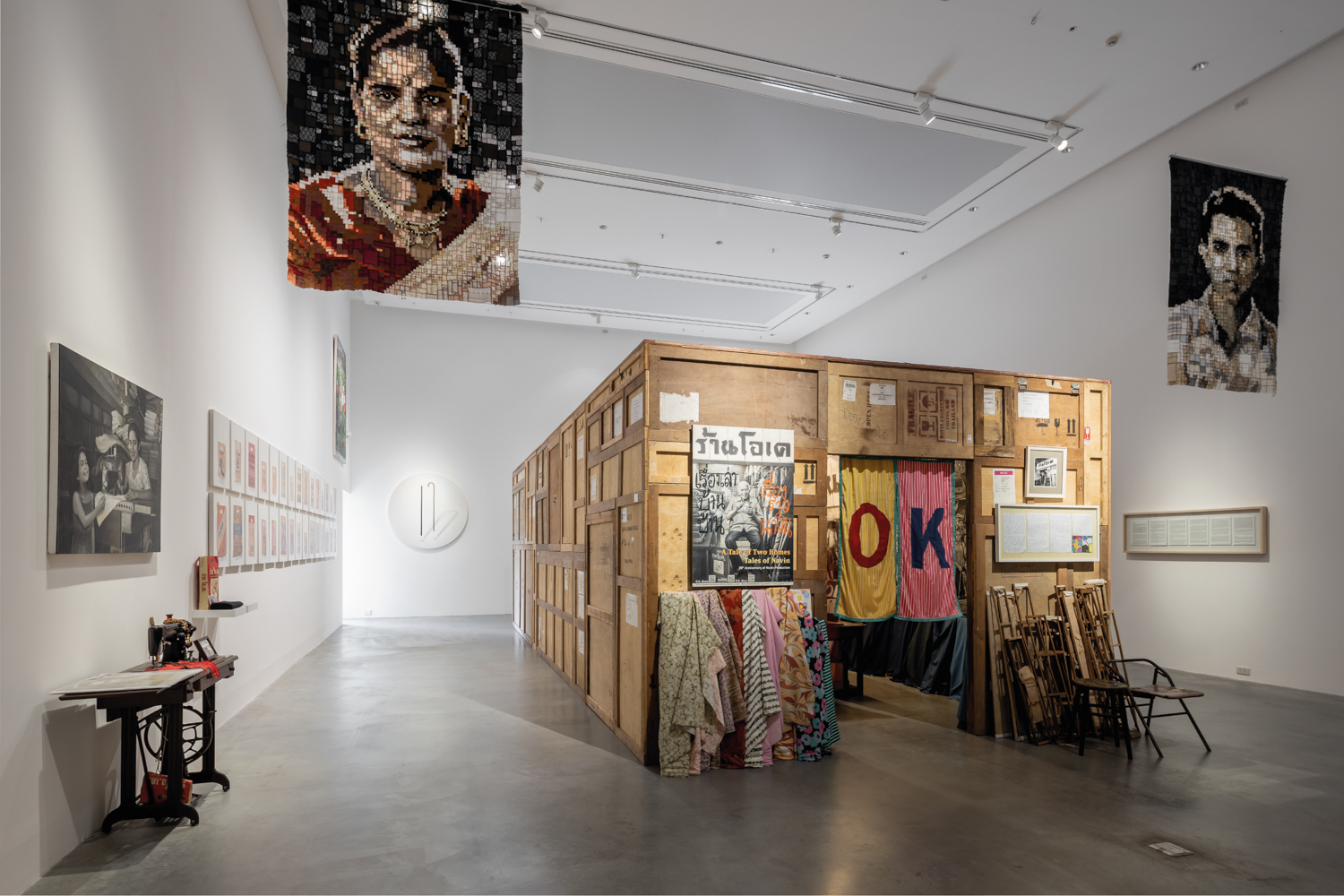NAVIN RAWANCHAIKUL’S LATEST EXHIBITION UNFOLDS THE WEB OF HIS MEMORIES THROUGH A CONSTELLATION OF NARRATIVES THAT TURN OUT TO BE A MEMORY COMPLEX
TEXT: TUNYAPORN HONGTONG
PHOTO: KETSIREE WONGWAN
(For English, please scroll down)
เรื่องราวความสัมพันธ์ระหว่างนาวินกับ มณเฑียร บุญมา (1953-2000) เป็นอีกส่วนใน ‘กลับไป จากมา’ ที่ต่อเนื่องมาจากผลงานก่อนหน้าของเขา ย้อนกลับไปในผลงานชิ้นก่อนๆ เราจะเห็นว่าเรื่องที่เกี่ยวกับมณเฑียร – ศิลปินระดับตำนานผู้เป็นอาจารย์ของนาวิน – ปรากฏอยู่ในศิลปะของเขามาตั้งแต่ปี 2010 เมื่อครั้งที่นาวินได้รับรางวัลศิลปาธร สาขาทัศนศิลป์ และเขียนจดหมายถึงมณเฑียรขึ้นฉบับหนึ่ง ส่วนในปี 2013 เมื่อนาวินกลับไปเยี่ยมบ้านหลังเก่าของมณเฑียร (ปัจจุบันเป็นร้านอาหารและ Montien Atelier) แล้วค้นพบร่องรอยการทำงานศิลปะและความรักที่มณเฑียรมีต่อครอบครัว เขาก็ได้ทำงานขึ้นมาอีกชิ้นคือ ‘House of Hope’ (Homage to Montien Boonma) (2013) ที่เป็นวิดีโอภาพ “คุณยาย” (แม่ของภรรยามณเฑียร) นั่งอยู่หน้าเปียโนในบ้านของมณเฑียร โดยวิดีโอนั้นฉายลงบนฉากสีขาวที่บริเวณเหนือเปียโนเป็นเพ้นท์ติ้งรูปครอบครัวของมณเฑียรที่นาวินจัดทำขึ้น และมีเสียงเปียโนเพลง Funeral March ที่นักดนตรีเล่นจากเปียโนของภรรยามณเฑียรบรรเลงคลอ

ใน ‘กลับไป จากมา’ ผลงานที่ว่ามาทั้งหมดยังอยู่ครบ รวมทั้งนาวินยังทำผลงานแบบ “After Montien” ที่เลือกเดินตามวิธีการทำงานศิลปะที่มณเฑียรเคยใช้ เช่น การที่มณเฑียรเคยให้ช่างฝีมือท้องถิ่นที่ช่วยเขาทำงานศิลปะ กำมือเพื่อประทับรอยมือลงบนก้อนดิน ก่อนนำไปเผา แล้วนำเอา “มือจับ” ดินเผาเหล่านั้นมาใช้ในงานศิลปะ มาคราวนี้นาวินก็ใช้วิธีเดียวกัน แต่เลือกให้พ่อของเขาเป็นผู้กำก้อนดิน นำไปเผาที่หมู่บ้านเหมืองกุง ในเชียงใหม่ ที่เดียวกับที่มณเฑียรเคยเดินทางไปทำงานดินเผา ก่อนนำมือจับที่เป็นรอยมือของพ่อมาประกอบเข้ากับประติมากรรมทำจากทองแดงรูปไม้เมตรและไม้เท้าที่จำลองมาจากไม้เท้าของทวดผู้เป็นบรรพบุรุษของตระกูลลาเวิล แม้ว่ารอยมือของพ่ออาจสื่อไปได้ถึงเรื่องอัตลักษณ์อย่างที่นาวินให้ความสนใจในช่วงหลังๆ แต่อาจมองได้อีกเช่นกันว่าเป็นการฝากร่องรอยของชีวิตและการทำงานหนักของพ่อในฐานะเจ้าของร้านผ้ามาตลอดหลายสิบปีเหมือนกับที่มณเฑียรเคยตั้งใจให้รอยมือเป็นสัญลักษณ์การใช้แรงงานของชาวชนบท*

เครื่องหมายคำถาม (?) และเครื่องหมายตกใจ (!) เป็นอีกมรดกตกทอดจากมณเฑียรที่นาวินนำมาใช้ เครื่องหมายทั้งสองเกิดขึ้นในช่วงที่ภรรยาของมณเฑียรล้มป่วย ในช่วงเวลานั้น มณเฑียรวาดเครื่องหมาย “?!” ลงบนกระดาษแล้วแปะทั่วห้องพักของภรรยาในโรงพยาบาล จากนั้นเครื่องหมาย “?!” จึงปรากฏเรื่อยมาในศิลปะของเขา โดยสำหรับมณเฑียรเครื่องหมายคำถามเป็นสัญลักษณ์ของการตระหนักรู้ผ่านการทำสมาธิ ส่วนเครื่องหมายตกใจแสดงถึงความรู้สึกเมื่อได้ตระหนักรู้**

ในนิทรรศการครั้งนี้ เครื่องหมายทั้งสองปรากฏให้เห็นในหลายบริบท ตั้งแต่ในงานศิลปะไปจนถึงโปสเตอร์นิทรรศการ แต่ชิ้นที่ดูจะนำเอา “?!” มาใช้ได้อย่างเข้าใจลึกซึ้งสมราคากับการที่มันเสมือนสัญลักษณ์ศักดิ์สิทธิ์ที่แสดงถึงความเข้าใจในชีวิตของมณเฑียรที่ได้มาจากโศกนาฏกรรมของตนเองคือ ‘Page 42: Very Beautiful’ (2019) ภาพโน้ตเพลง Funeral March ที่นาวินและทีมงานนำผงฝุ่นที่เก็บมาจากบ้านเก่าบนร้านโอเคและขี้เถ้าที่ได้จากการเผาประติมากรรมไม้เมตรเมื่อปี 2015 มาวาดโน้ตเพลง แต่แทนที่ตัวโน้ตต่างๆ บนบรรทัดห้าเส้นด้วยเครื่องหมายคำถามและตกใจ เพลง Funeral March นี้มีความสำคัญกับมณเฑียร คือเป็นเพลงที่เขาชอบฟังเวลาภรรยาเล่นเปียโนและเคยตั้งใจให้ใช้เปิดในงานศพของตนเอง ระหว่างที่มณเฑียรพักรักษาอาการป่วยอยู่ที่บ้าน เขายังเปิดหน้า 42 ของหนังสือ Piano Pieces For Children ที่มีโน้ตเพลงนี้ทิ้งไว้บนเปียโนของภรรยาและขอให้เพื่อนที่ไปเยี่ยมเล่นเพลงนี้ให้ฟัง
อ่านบทความฉบับเต็มได้ใน art4d No.266
*มณเฑียร บุญมา. กิจกรรมของชีวิตชนบท, วิทยานิพนธ์ปริญญาศิลปมหาบัณฑิต, คณะจิตรกรรม ประติมากรรมและภาพพิมพ์ มหาวิทยาลัยศิลปากร. พ.ศ. 2532.
**’ตายก่อนดับ: การกลับมาของ มณเฑียร บุญมา’ สูจิบัตรนิทรรศการ, จัดที่พิพิธภัณฑสถานแห่งชาติ หอศิลป, กุมภาพันธ์ – เมษายน พ.ศ. 2548


‘Revisited <> Departed’ (2019), is Navin Rawanchaikul’s latest exhibition at BANGKOK CITYCITY GALLERY, feels like a sequel of ‘A Tale of Two Homes’ (2015) and ‘Tales of Navin’ (2015), two of his exhibitions which took place at OK Store (his family’s textile shop) and StudiOK in Chiang Mai, 4 years ago. The reasons for this is not only because elements of his previous exhibitions were shown but also due to the fact that the work which Rawanchaikul created afterwards was still closely associated with the story of his family. One of them is Dad, Mom & Me’ (2015-2018) where he and his team created large piece of art by quilting thousands of pieces of fabric from OK Store into the portraits of the artist’s parents in their younger years. Another quilt piece was created in the image of Rawanchaikul’s own x-rayed skull.
The relationship between Rawanchaikul and Montien Boonma (1953-2000) is another part of ‘Revisited <> Departed’ and a continuum of his previous work. Looking back at his artistic chronicle, one can witness the story of the legendary artist who played a role as Rawanchaikul’s mentor. In 2010, when he received the Silpathorn Awards in Visual Arts, he wrote a letter to Boonma. In 2013, when he visited the late artist’s old house (now renovated into a restaurant and Montien Atelier) and found traces of Boonma’s artistic process and love for his family, he created ‘House of Hope’ (Homage to Montien Boonma) (2013) as a result of the experience. The piece of art was in the form of a video footage of ‘grandma’ (Boonma’s mother-in-law) sitting in front of the piano in his home. The video is screened on a white backdrop of which the painting of Boonma’s family created by Rawanchaikul is located in the middle. In the background, there is the sound of the Funeral March record that musician played it with the piano of Boonma’s wife.

In his previous exhibition, “Tales of Navin”, the artist uses black cloth with gold ‘?’ and ‘!’, the symbols Boonma used in his work ‘Room’ (1994) (Rawanchaikul traveled to Australia to exhibit this installation on behalf of Boonma), as a part of his own ‘Gate of Fear’ (2015). He also created a coffin-like sculpture using the textile paper tubes from the OK Store and organized a funerary rite before the Stupa-shaped sculpture was cremated on the day StudiOK first opened. The merits were made for the late Boonma, just like how Boonma had created ‘Body Temple’ (1995) and cremated it to dedicate to his departed wife.
In ‘Revisited <> Departed’, all the aforementioned works are included. Rawanchaikul also takes the ‘After Boonma’ approach, retracing his mentor’s artistic methods. One of the examples of this is the way Boonma used to ask the local artisans who helped him making his art to press their hands on clods before firing it in a kiln and using the earthen handles as a part of his art pieces. He follows this particular method but instead, uses the hands of his father. The clods were fired at Muang Goong Village in Chiang Mai where Boonma used to travel to work on his sculptures. The handles with his father’s handprints on them are attached the copper sculptures created in the shape of a meter rule and cane simulated from the cane of his great-grand- father, the ancestor of the Rawal Family. While the handprints of his father can be associated with the issue of identity, which has been something that Rawanchaikul has been showing great interest in the last couple years. It can be also viewed as his way of leaving the traces of his father’s life and years of hard work of running the family’s textile shop, just like it was Boonma’s intention for the imprinted hands to symbolize the labor of rural people.*

The symbols “?” and “!” are Boonma’s legacy that Rawanchaikul also uses in his work. The two symbols started to appear in Boonma’s work when his wife became ill. During that time, he drew “?!” on various pieces of paper and put them up on the walls of his wife’s hospital room. The symbols had later been frequently found in his art. For Boonma, the question mark symbolizes his own self realization brought about by the meditation of the mind while the exclamation point conveys the feelings after the process had taken place.**

In this exhibition, the two symbols can be found in several contexts, from the art work to the exhibition’s poster. However, the most profound piece of all within the exhibition that truly reflects a sacred symbol of Boonma’s understanding of life in correspondence with his own tragedy is ‘Page 42: Very Beautiful’ (2019). The painting of the ‘Funeral March’ score was made by using the dust collected from Rawanchaikul’s old home which is located above OK Store and the ashes from his cremated meter rule sculpture (2015) while replacing the musical notes with the symbol “?” and “!”. The song ‘Funeral March’ is particularly meaningful for Boonma since it’s the song he often listened to since his wife played it on the piano and it was intended to be played at his own funeral. While he was recovering from his illness at home, he would turn to page 42 of the book ‘Piano Pieces For Children’ which contained the notes of the song and placed it on his departed wife’s piano, occasionally asking friends who visit to play the tune for him.
Read the full article in art4d No.266
*Montien Boonma, ‘Manual activities in rural life’, Master Degree Thesis, Faculty of Painting Sculpture and Graphic Arts, SIlpakorn University, 1989.
**Death before Dying: The Return of Montien Boonma exhibition, National Gallery in Bangkok, February – April 2005.

